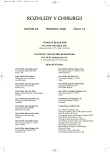Historical Review of Opinions on the Nature of Varicose Veins and Leg Ulcers and their Treatment
Historický přehled názorů na povahu a léčení varixů a bércových vředů
V článku je popsán vývoj názorů na povahu a léčení varixů a bércových vředů od starověku až do naší doby. Zatím co v antickém období (Hippokrates, Celsus, Galen) nebyly názory na povahu tohoto onemocnění a jeho léčení v podstatě v rozporu s dnešními poznatky, od 11. až do poloviny 19. století převládly pod vlivem Avicennovy humorální teorie kuriózní názory, které se udržely po osm století jako oficiální nauka. Podle nich se ve varixech hromadila černá žluč a tělu nebezpečné tekutiny. Proto bylo odmítáno i bandážování varixů z obavy, aby tyto zlé tekutiny nezaplavily tělo a nezpůsobily pominutí smyslů nebo jiné závažné onemocnění. Naopak vznik bércových vředů byl považován za blahodárnou situaci pro nemocného, neboť tělo se tím zbavovalo oněch nebezpečných tekutin.
Základy moderní chirurgie varixů položili Madelung, Trendelenburg a Babcock na přelomu 19. a 20. století. Trendelenburgovou zásluhou je, že do flebochirurgie přinesl principy fyziologického a patofyziologického uvažování. V dalším průběhu názory na roli insuficientních bércových perforátorů při tvorbě bércových vředů prezentované především Cockettem a jeho následovníky představují opět určité vykolejení mimo sféru evidence based medicine. I když většina flebologů a flebochirurgů ještě v současné době pokládá teorii insuficientních perforátorů za správnou, její podstata byla opětovně vyvrácena přesnými hemodynamickými měřeními a objektivně prokázanými skutečnostmi. Evidence based medicine, jejíž základy položil Trendelenburg před více než sto lety, si ve flebologii jen obtížně razí cestu.
Klíčová slova:
varixy – bércové vředy
Authors:
Č. Reček
Authors‘ workplace:
autor je v důchodu, dřívější pracoviště: Chirurgická klinika, Hradec Králové
Published in:
Rozhl. Chir., 2006, roč. 85, č. 12, s. 641-645.
Category:
Monothematic special - Original
Overview
The development and changes of opinions conceming the nature and treatment od varicose veins and varicose ulcers are summarized in this article covering a long period from the Greek antiquity till the 20th century. Whereas in the ancient times (Hippokrates, Celsus, Galen) the meanings did not contradict the contemporaneous knowledge, curious opinions dominated from the 11th till the half of the 19th century, obviously influenced by the humoral theory of Avicenna. The official teaching claimed that black bile and other bad humours collected in varicose veins. Bandaging was thought to push back these humours into the body and cause madness or other serious illness and, therefore, was refused. On the contrary, ulcers were considered to be a favourable condition because their function was to drain the bad humours.
The fundamentals of modern surgical treatment of varicose veins were presented by Madelung, Trendelenburg and Babcock at the end of the 19th and the beginning of the 20th century. Trendelenburg deserves acknoledgement of having introduced physiological and pathophysiological reasoning into the field of phlebology. The conception of the role of incompetent calf perforators for the development of leg ulcers advocated by Cockett and others represents a derailment on the way of evidence based medicine. The substance of this theory, although supported by most autors till the present time, have been repeatedly confuted by exact hemodynamic measurements. Evidence based medicine whose basement was laid by Trendelenburg more than 100 years ago cuts a difficult way through the field of phlebology.
Key words:
varicose veins – leg ulcers
Labels
Surgery Orthopaedics Trauma surgeryArticle was published in
Perspectives in Surgery

2006 Issue 12
- Metamizole at a Glance and in Practice – Effective Non-Opioid Analgesic for All Ages
- Metamizole vs. Tramadol in Postoperative Analgesia
- Safety and Tolerance of Metamizole in Postoperative Analgesia in Children
Most read in this issue
- Consequennce of Nontreatment Scapholunate Instability of the Wrist
- Anterior Skull Base Reconstruction
- Autovenous Ilicofemoral Bypass, 21 Years Later – A Case-Review
- Gastric Carcinoid – A Case Review
